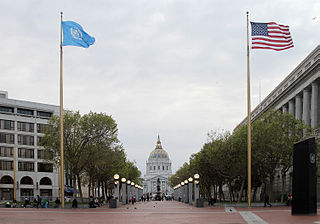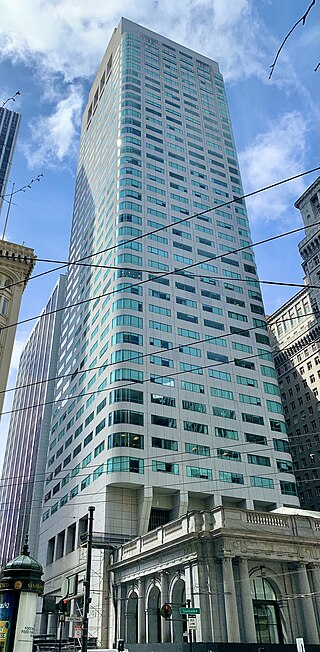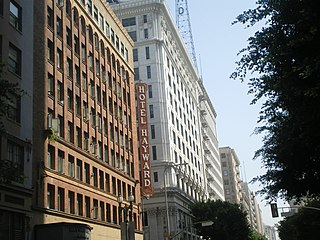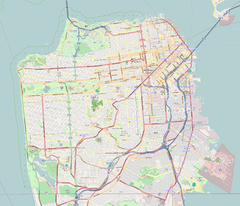
The San Francisco LGBT Community Center, also known as the SF LGBT Center, is a nonprofit organization serving the lesbian, gay, bisexual, transgender, and queer community of San Francisco, California, and nearby communities, located at 1800 Market Street in San Francisco. The mission of the SF LGBT Center is "to connect the diverse LGBTQ+ community to opportunities, resources, and each other to achieve a stronger, healthier, and more equitable world for LGBTQ+ people and our allies."

The Civic Center in San Francisco, California, is an area located a few blocks north of the intersection of Market Street and Van Ness Avenue that contains many of the city's largest government and cultural institutions. It has two large plazas and a number of buildings in classical architectural style. The Bill Graham Civic Auditorium, the United Nations Charter was signed in the Veterans Building's Herbst Theatre in 1945, leading to the creation of the United Nations. It is also where the 1951 Treaty of San Francisco was signed. The San Francisco Civic Center was designated a National Historic Landmark in 1987 and listed in the National Register of Historic Places on October 10, 1978.

The Emporium, from 1880 to 1995 Emporium-Capwell, was a mid-line department store chain headquartered in San Francisco, California, which operated for 100 years—from 1896 to 1996. The flagship location on San Francisco's Market Street was a destination shopping location for decades, and several branch stores operated in the various suburbs of the Bay Area. The Emporium and its sister department store chains were acquired by Federated Department Stores in 1995, and many converted to Macy's locations.

One Sansome Street, also known as Citigroup Center, is an office skyscraper located at the intersection of Sutter and Sansome Streets in the Financial District of San Francisco, California, United States, near Market Street. The 168 m (551 ft), 41 floor, 587,473 sq ft (54,578.0 m2) office tower was completed in 1984.

The Tenderloin is a neighborhood in downtown San Francisco, in the flatlands on the southern slope of Nob Hill, situated between the Union Square shopping district to the northeast and the Civic Center office district to the southwest. Encompassing about 50 square blocks, it is historically bounded on the north by Geary Street, on the east by Mason Street, on the south by Market Street and on the west by Van Ness Avenue. The northern boundary with Lower Nob Hill has historically been set at Geary Boulevard.

1 Wall Street Court is a residential building in the Financial District of Manhattan in New York City, United States. The 15-story building, designed by Clinton and Russell in the Renaissance Revival style, was completed in 1904 at the intersection of Wall, Pearl, and Beaver Streets.

The McElroy Octagon House, also known as the Colonial Dames Octagon House, is a historic octagonal house now located at 2645 Gough Street at Union Street in the Cow Hollow neighborhood of San Francisco, California, United States.

Spring Street in Los Angeles is one of the oldest streets in the city. Along Spring Street in Downtown Los Angeles, from just north of Fourth Street to just south of Seventh Street is the NRHP-listed Spring Street Financial District, nicknamed Wall Street of the West, lined with Beaux Arts buildings and currently experiencing gentrification. This section forms part of the Historic Core district of Downtown, together with portions of Hill, Broadway, Main and Los Angeles streets.

Albert Pissis (1852–1914) was a prolific Mexican-born American architect, of French and Mexican descent. He was active in San Francisco and had studied at the École des Beaux-Arts in Paris, France. He is credited with introducing the Beaux-Arts architectural style to San Francisco, California, designing a number of important buildings in the city in the years before and after the 1906 San Francisco earthquake.

49 Chambers, formerly known as the Emigrant Industrial Savings Bank Building and 51 Chambers Street, is a residential building at 49–51 Chambers Street in the Civic Center neighborhood of Manhattan in New York City. It was built between 1909 and 1912 and was designed by Raymond F. Almirall in the Beaux-Arts style. The building occupies a slightly irregular lot bounded by Chambers Street to the south, Elk Street to the east, and Reade Street to the north.

The Old Federal Reserve Bank of San Francisco Building, now known as the Bently Reserve, was the main headquarters building of the Federal Reserve Bank of San Francisco for nearly sixty years. The building is located at 400 Sansome Street, in the Financial District of San Francisco. Designed by George W. Kelham, the building has an Ionic colonnade that is pure Beaux-Arts, while the upper building is in the new Moderne fashion of 1924. The banking lobby at the Sansome Street entrance contains a mural by Jules Guerin, the artist who created the palette for the 1915 Panama–Pacific International Exposition. The Old Federal Reserve was added to the National Register of Historic Places in 1984.

The Flood Building is a 12-story highrise in the downtown shopping district of San Francisco, California. It is located at 870 Market Street on the corner of Powell Street, next to the Powell Street cable car turntable, Hallidie Plaza, and the Powell Street BART Station entrance. Designed by Albert Pissis and completed in 1904 for James L. Flood, son of millionaire James Clair Flood, it is one of the few major buildings in San Francisco that survived the 1906 earthquake and fire. As of 2024, it is still owned by the Flood family.

Mid-Market is a neighborhood, historic district and development area in San Francisco, California. The neighborhood is bounded by Market Street to the north, 5th Street to the east, Mission Street to the south, and Van Ness Avenue to the west. There are many theaters in the district, most of which began as vaudeville theaters, include the Warfield and Golden Gate.

The James Lick Baths in the South of Market District of San Francisco, California is a San Francisco Designated Landmark combining aspects of public bathing and self-service laundry.

The Borel & Co. building is a historic building built in 1908 and located at 440 Montgomery Street in San Francisco, California. The building is a small, two story, granite-faced, steel frame building.

The Ritz-Carlton Club and Residences is a 312-foot (95 m) luxury residential skyscraper in the Financial District of San Francisco, California. The residences are built atop the historic Old Chronicle Building, sometimes called the de Young Building, which was constructed in 1890. It is the first skyscraper built in California.

The Old San Francisco Mint is a building that served as the location of the San Francisco branch of the United States Mint from 1874 until 1937. The building is one of the few that survived the great 1906 San Francisco earthquake and resulting fire. It was designated a National Historic Landmark in 1961, and as a California Historical Landmark in 1974.

Shipwright's Cottage is a historic house built c. 1875 and located at 900 Innes Avenue in India Basin, San Francisco, California. The building is part of a new city park, scheduled for completion in 2025. It is thought that the property has one of the only natural Bay shoreline remaining in San Francisco.

The Uptown Tenderloin Historic District is a historic district located in the Tenderloin neighborhood of San Francisco, California, U.S.. It has 408 contributing buildings and covers roughly a 33-city block radius in downtown San Francisco. The Uptown Tenderloin Historic District was listed on the National Register of Historic Places on February 5, 2009, for architecture and social history.

The Cadillac Hotel is a historic building from c. 1907 – c. 1908 in the Tenderloin neighborhood of San Francisco, California, U.S.. It was the first non-profit single-residence occupancy (SRO) hotel in the Western United States. Since 2015, the first two floors of the building is the home to the Tenderloin Museum, a cultural history museum dedicated to the neighborhood. It was called the A.A. Louderback Building, and nicknamed "The House of Welcome" during the early 20th-century.






















